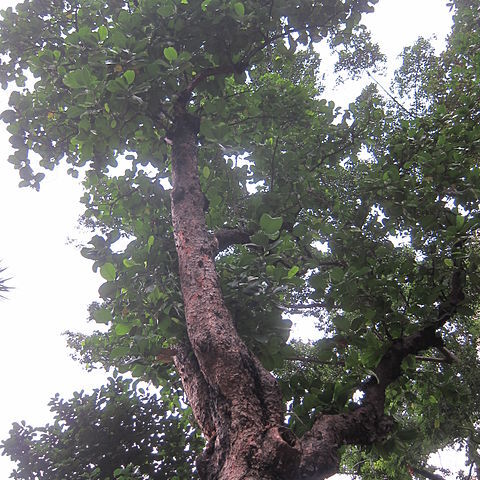A small to medium sized tree. It grows to 10-18 m high and spreads to 4-10 m across. The trunk is smoothly round. It has a dense rounded evergreen crown. The bark is loose and flaky. It is reddish brown and bright in colour. The leaves are smooth and produced one after another along the stem. They are often grouped into rings around the stem. They are a rich glossy green. They are broadly oval with a lobe at the base. The leaf blade is 13-25 cm long by 8-12 cm wide. The veins show up clearly and they are raised underneath the leaf. The tip of the leaf is rounded. The leaf stalk has prominent wings and is 5.5 cm long. The flowers are bright yellow. They have 5 petals and 5 spreading lobes. The flowers are 5-8 cm across. There are usually 2-4 flowers together in a cluster at the end of a branch. The fruit is smooth, open, flat and fleshy. They are 4-4.5 cm across. There are 6-8 segments. These open out in a spreading fashion. The fruit are pinkish red when ripe. The fruit contain small brown seeds in a white seed layer. The seed are 5 mm across.
Tree, up to 20 m high, 60 cm diam., with reddish brown bark peeling off in thin papery flakes, and crooked branches. Leaves ovate to elliptic, ca 8-14-nerved, 8-25 by 5-15 cm, with rounded apex and base and entire, slightly recurved margin. Petiole 2½-4 cm long, with 2-6 mm broad wings; wings narrowing towards the base of the blade, partly caducous, leaving behind a ½ mm broad part on the lower ½-3/5 of the petiole, the wing on the upper 2/5-¼ permanent. Raceme 2-4-flowered. Flowers ca 7½ cm diam. Sepals 5, the outer 2 circular, 1.3 cm diam., the inner 3 elliptic-ovate, 2 by 1½ cm. Petals yellow, 40 by 25 mm. Stamens in 2 distinct groups, the outer ones ca 100, 7-8 mm long, straight in bud, the inner ones ca 18, 11-13 mm long, with their apex reflexed in bud. Carpels 6-8, deep crimson, ca 10 by 4 mm, with red, ca 14 mm long styles, each with ca 8 ovules. Fruit dehiscent. Carpels 18-20 by 10-14 mm, 1-3-seeded. Seeds 4 by 3 mm, black, enclosed by a membranaceous, waxy white aril.


